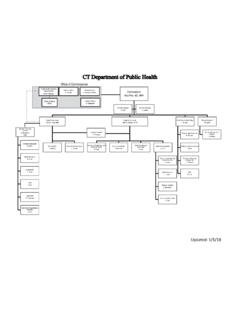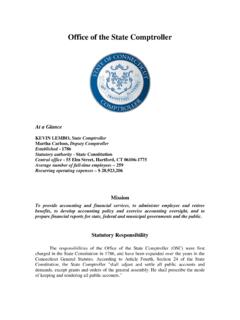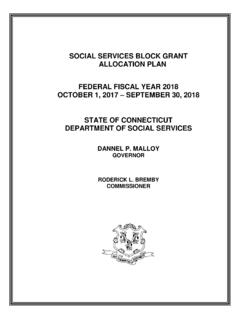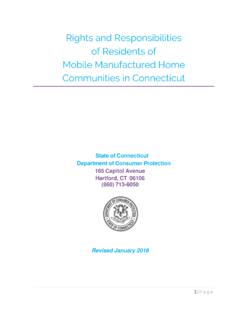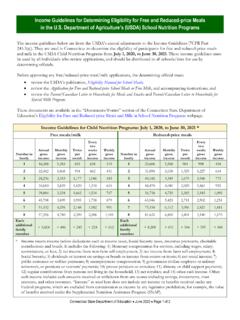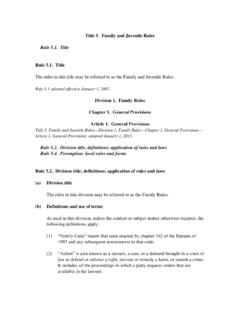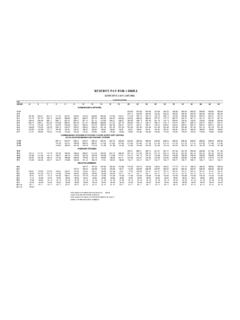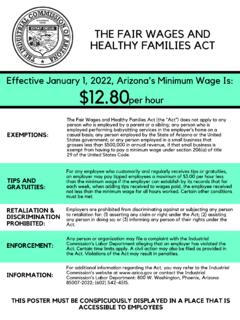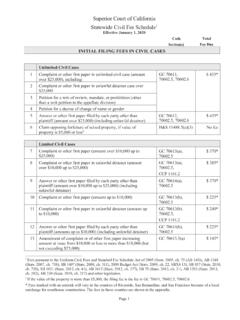Transcription of Withholding Calculation Rules Effective January 1, 2021
1 Page 1 of 6 TPG-211, 2021 Withholding Calculation Rules (Rev. 12/20) Withholding Calculation RulesEffective January 1, 2021 The 2021 Withholding Calculation Rules and 2021 Withholding tables are unchanged from the steps below to determine the amount of Connecticut income tax to be withheld from an employee s wages. Step1. Determine the employee s wages per pay Determine the number of pay periods in a year (for example: 52, 26, 24, 12).3. Determine the annualized salary. Multiply Step 1 by Step Determine the employee s Withholding code (A, B, C, D, or F from Form CT W4, Line 1).5. Use the annualized salary (Step 3) and employee s Withholding code (Step 4) to determine the exemption amount from Table A - Personal Determine the annualized taxable income.
2 Subtract Step 5 from Step 3. If the annualized taxable income is equal to or less than zero, the initial Withholding amount should equal zero. Proceed to Step Determine the initial tax amount from Table B - Initial Tax Use the annualized salary (Step 3) and employee s Withholding code (Step 4) and go to Table C - 3% Tax Rate Phase-Out Add-Back to determine the amount to add back if the 3% tax rate phase out Use the annualized salary (Step 3) and employee s Withholding code (Step 4) to determine the tax recapture amount from Table D - Tax Add the Withholding amounts from Step 7, Step 8, and Step Use the annualized salary (Step 3) and employee s Withholding code (Step 4)
3 To determine the decimal amount from Table E - Personal Tax Multiply the Withholding amount (Step 10) by minus the decimal amount (Step 11). Example: .15 = .85. This is the total Withholding amount. 13. Divide the result from Step 12 by the number of pay periods in the year (Step 2). This is the Withholding amount per pay Determine the additional Withholding amount per pay period, if any, from Form CT W4, Line Determine the reduced Withholding amount per pay period, if any, from Form CT W4, Line Determine the total Withholding amount per pay period: Add Step 13 and Step 14 or subtract Step 15 from Step 13.
4 The result cannot be less than zero (0).Employers: Use either the Withholding Calculation Rules or the Withholding tables to determine the amount of tax to be withheld from the wages of employees. There is no percentage method available to determine Connecticut wage Withholding Rules for supplemental compensation (such as bonuses, commissions, overtime pay, sales awards, etc.), refer to Informational Publication 2021(1), Connecticut Employer s Tax Guide, Circular Tax Withholding Requirements for Pension and Annuity Payments: Payers of taxable pension or annuity distributions are required to deduct and withhold income tax from such distributions.
5 Payers making periodic payments must calculate the amount to withhold from such distributions using the same method that employers use to determine the amount to withhold from wages. Therefore, such payers must use these Withholding Calculation Rules along with the recipient s most recently completed Form CT-W4P, Withholding Certificate for Pension or Annuity Payments. For additional information see Informational Publication 2021(8), Connecticut Tax Guide For Payers of Nonpayroll 2 of 6 TPG-211, 2021 Withholding Calculation Rules (Rev. 12/20)Table A - Personal Exemptions** For Withholding Code D , the Personal Exemption is $0 Less Than or More than Exemption Equal to Less Than or More than Exemption Equal to Less Than or More than Exemption Equal to Less Than or More than Exemption Equal to Withholding Code A Withholding Code B Withholding Code C Withholding Code F Annualized Salary Annualized Salary Annualized Salary Annualized SalaryUse these tables in completing the Withholding Calculation .
6 $ 0 $24,000 $12,000 $ 0 $38,000 $19,000 $ 0 $48,000 $24,000 $ 0 $30,000 $15,000 $24,000 $25,000 $11,000 $38,000 $39,000 $18,000 $48,000 $49,000 $23,000 $30,000 $31,000 $14,000 $25,000 $26,000 $10,000 $39,000 $40,000 $17,000 $49,000 $50,000 $22,000 $31,000 $32,000 $13,000 $26,000 $27,000 $ 9,000 $40,000 $41,000 $16,000 $50,000 $51,000 $21,000 $32,000 $33,000 $12,000 $27,000 $28,000 $ 8,000 $41,000 $42,000 $15,000 $51,000 $52,000 $20,000 $33,000 $34,000 $11,000 $28,000 $29,000 $ 7,000 $42,000 $43,000 $14,000 $52,000 $53,000 $19,000 $34,000 $35,000 $10,000 $29,000 $30,000 $ 6,000 $43,000 $44,000 $13,000 $53,000 $54,000 $18,000 $35,000 $36,000 $ 9,000 $30,000 $31,000 $ 5,000 $44,000 $45,000 $12,000 $54,000 $55.
7 000 $17,000 $36,000 $37,000 $ 8,000 $31,000 $32,000 $ 4,000 $45,000 $46,000 $11,000 $55,000 $56,000 $16,000 $37,000 $38,000 $ 7,000 $32,000 $33,000 $ 3,000 $46,000 $47,000 $10,000 $56,000 $57,000 $15,000 $38,000 $39,000 $ 6,000 $33,000 $34,000 $ 2,000 $47,000 $48,000 $ 9,000 $57,000 $58,000 $14,000 $39,000 $40,000 $ 5,000 $34,000 $35,000 $ 1,000 $48,000 $49,000 $ 8,000 $58,000 $59,000 $13,000 $40,000 $41,000 $ 4,000 $35,000 and up $ 0 $49,000 $50,000 $ 7,000 $59,000 $60,000 $12,000 $41,000 $42,000 $ 3,000 $50,000 $51,000 $ 6,000 $60,000 $61,000 $11,000 $42,000 $43,000 $ 2,000 $51,000 $52,000 $ 5,000 $61,000 $62,000 $10,000 $43,000 $44,000 $ 1,000 $52,000 $53,000 $ 4,000 $62.
8 000 $63,000 $ 9,000 $44,000 and up $ 0 $53,000 $54,000 $ 3,000 $63,000 $64,000 $ 8,000 $54,000 $55,000 $ 2,000 $64,000 $65,000 $ 7,000 $55,000 $56,000 $ 1,000 $65,000 $66,000 $ 6,000 $56,000 and up $ 0 $66,000 $67,000 $ 5,000 $67,000 $68,000 $ 4,000 $68,000 $69,000 $ 3,000 $69,000 $70,000 $ 2,000 $70,000 $71,000 $ 1,000 $71,000 and up $ 0 Page 3 of 6 TPG-211, 2021 Withholding Calculation Rules (Rev.)
9 12/20) Withholding Code A, D, or FIf the amount from Step 6 is:Less than or equal to: .. $ 10,000 .. than $10,000, but less than or equal to .. $ 50,000 ..$300 plus of the excess over $10,000 More than $50,000, but less than or equal to .. $100,000 ..$2,300 plus of the excess over $50,000 More than $100,000, but less than or equal to .. $200,000 ..$5,050 plus of the excess over $100,000 More than $200,000, but less than or equal to .. $250,000 ..$11,050 plus of the excess over $200,000 More than $250,000, but less than or equal to .. $500,000 ..$14,300 plus of the excess over $250,000 More than $500,000.
10 $31,550 plus of the excess over $500,000 Withholding Code BIf the amount from Step 6 is:Less than or equal to: .. $ 16,000 .. than $16,000, but less than or equal to .. $ 80,000 ..$480 plus of the excess over $16,000 More than $80,000, but less than or equal to .. $160,000 ..$3,680 plus of the excess over $80,000 More than $160,000, but less than or equal to .. $320,000 ..$8,080 plus of the excess over $160,000 More than $320,000, but less than or equal to .. $400,000 ..$17,680 plus of the excess over $320,000 More than $400,000, but less than or equal to .. $800,000.


